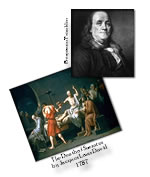 ENG 241: Survey of American Literature I
ENG 241: Survey of American Literature I
Judy Riggin
Week 7
[Introduction] [Your Responsibility] [Syllabus] [Assignments] [Exams] [Resources]
Week 7 |
Text Reading :
-
Introduction, pp. 556-559, 777-779
-
Edwards, pp. 620-622
-
Franklin , pp. 782-794, 802-805, 805-867
-
Adams , pp. 954-957
[Top]
Program Six :
The following link is to an outline of the main ideas in Program Six. Use this interactive outline to guide you through the video. Print off a copy of this outline and add your own notes. Using this link requires a broadband connection and Windows media player 8 or higher.
[Top]
Journal # 3 :
Directions:
-
Using MS Word, write a discussion approximately 300 words in length ( no more than ONE typed page) on ONE of the following topics:
-
A. Describe the persona Franklin presents in “The Speech of Polly Baker” and explain how this persona suits his purpose for writing.
-
B. Imagine William Byrd and Benjamin Franklin meet at a party in London . Describe the meeting, including the topics they might talk about, whether or not they would agree on those topics, and whether they would like each other. If you choose, you can write this as an imaginary dialogue, but include some of their actual words (from selections you've read) as part of their talk.
-
C. Explain how Woolman's and Franklin's attitudes toward business and making money are different.
-
D. Explain whether or not you would choose Benjamin Franklin, as he depicts himself in The Autobiography , as a model for the way to live your life.
-
-
Save your file as: [your last name]_journal3.doc (example: Riggin_journal3.doc)
-
Attatch document to an email and email as directed below:
Email instructions:
Email to jriggin@nvcc.edusubject line should read:[your last name] Journal # 3Example: Riggin Journal # 3
Grading Criteria:
This writing will earn thirteen (13) points when submitted, regardless of content or style. It will earn an additional seven- (7) points if it meets these criteria:
• The central idea has been narrowed to a thesis that responds to one of the topics and that can be explained in some detail in approximately 300 words (one typed page).
• The thesis is supported or illustrated by at least three brief quotations from the literary work(s) being discussed. (Quotes from the editor's introductory materials don't count!)
• Your writing is virtually free of errors in grammar, punctuation, and spelling. Review 'How To: Read, Watch, and Write About Literature'
What To Study for Exam #2:
In the TEXT introductions, the editors provide a very thorough background to your readings. In particular, you should study these topics for Exam #2:
• important thinkers and ideas of the Enlightenment (pp. 556-557 ), ALONG WITH SUPPLEMENT BELOW
• religious thought--the Great Awakening, Deism (pp.557-559 )
• slavery (pp. 565-568)
For supplementary study, I offer the following diagram of the important concepts of the Enlightenment as they relate to the central principle--the power of human reason:

What I intend you to see in this diagram is that the ability of humans to reason was at the center of Enlightenment thought. Rationality was the key, and with it, human beings could unlock the laws that governed the workings of the universe and of society. With such knowledge, humans could progress in what Franklin termed "the bold and arduous Project of arriving at moral Perfection," as well as moving toward the perfection of government, the arts, and the society of daily life. Harm and difficulty came when human reason failed, either through ignorance or excessive emotion. Therefore, the eighteenth century was an age of optimism and hope. Human nature and reason could create a perfect world, and many thought that the new America created by the revolution was the perfect world.
Here is an overview of neoclassicism, the aspect of the Enlightenment related to artistic taste and standards:
NEOCLASSICISM
1. Dominates as a set of artistic ideals in America in the 1700s (somewhat earlier in Europe ).
2. Draws from influences and models in the writing and artistic theory of the classical Greeks and Romans.
3. Values art that is centered on humans as subject matter; that can be judged in terms of service to humans; and that aims to delight, instruct, and correct humans as social beings.
4. Values design and rationality in its forms ( i.e., order, logic, symmetry, decorum, good taste, balance, and wit).
5. Produces writing (art) that is public, urbane, witty, reasoned, intellectual, and emotionally restrained.
6. Produces a ”great age” of the essay, of letters, of satire, of parody, and of moral instruction.
[Top]
